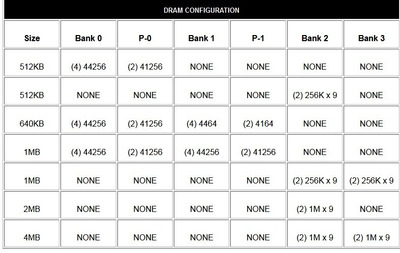I stupidly overlooked the cmosX section of the BIOS. It's got a bunch of wait state (I/O and RAM) and clock selection options. It was already set to 0 ws for the RAM, though, and I don't think it's quite as fast as some other 12.0 MHz systems at 0WS, but not slow either.
Weird to have a board of this era configure that in the BIOS and not via jumpers, but interesting. I didn't find any RAM size/address space configuration options in that portion of the BIOS and the 384kB relocate doesn't seem to do anything with the DIP RAM. (might only work with SIPPs, even just the 4x 256kB SIMM config)
Landmark 6.0 says it's a 18.5 MHz AT (and drops to 13.87 when I set it to 1 WS) vs my M205 which got 18.41 at 12.5 MHz. (I'm not sure what to think about the D60 chipset now, either it's rather fast at 1WS or slow at 0WS) Though I guess these WS options aren't absolute 0 or 1 WS, but might be +0 or +1 on top of hard-coded chipset waitstates that aren't visible to the user.
Swapping faster oscillators into this 1212C might shed more light on that though.
And yes, I got mine booting DOS 5.0 off the same 170 MB IDE drive I've been playing with for a while (well, it was a matched pair, but its twin seems to have died or gotten even flakier ... no click of death and the bearing/motor whine isn't any worse than it was, but just gives disk failure errors now).
It ran wolfenstein 3D fine with sound blaster sound and all. (actually playable at the default screen size, though I swear Wolf3D runs fast+choppy and twitchy on the 286, and feels too-fast and choppy/twitchy at 20 or 25 MHz, like it uses different code than when on a 386 or higher ... maybe it's keyboard polling, but is fairly normal feeling at 12 MHz here ... though might be painful to play at higher difficulty settings)
X-Wing works, but only with no sound since I couldn't get XMS or EMS detected, DOS loaded low, 580 kB available. (no UMA detected either, I think, though DOS 5 doesn't have as complete a mem table as 6.2) It's slow of course, but does run, 3D renderer/sim engine included. (Wing Commander would be better suited ... or Lucasfilm's Secret Weapons of the LW trilogy)
I want to say AMI BIOSs are less trouble, and it seemed the case when I swapped one into my ACT based EAT-12 board (instead of the Quadtel one) but that was a very limited sample size there and I can't even re-try it now as that board has stopped posting. (I may have just worn out the already oxidized RAM sockets swapping chips too many times, but it might be something else ... that hard drive died at the same time, so it's even more confusing)
If nothing else, the AMI BIOS has a more familiar interface and layout if you're used to AMI and Award (and maybe some vintages of Phoenix), though it's just hitting escape and y/n to save rather than F10, but still normal page up/down for select and such. (the Quadtel one was weird/annoying using function keys for variable select) Albeit, like some other late 80s or 1990 vintage AMI bioses (or all 286 ones?) numlock is only partially recognized, so you can start typing in digits and accidentally hit the up or down arrow. (I keep forgetting that and get through the 1011 cylinders, 15 heads, 1010 Landing zone, 1 precomp, and then arrow-down when I got to type 22 sectors 🤣 )
And I haven't tried SIPPs yet successfully, but my board won't post with both types installed (or even 1 SIPP installed), and it definitely seems stuck at seeing only 640kB of the 1MB DIP chips installed. Maybe they cheaped out and simply supported 640kB addressing there, but allowed either 8x 1Mbit chips or 4x 1M + 4x 256kbit ones to be used for the same purpose. (useful when the 1Mbit 256kx4 are more available, but also kind of lazy)
The D60 (and I think HT12) boards with DIP + SIPP/SIMM sockets don't tend to do that, so hopefully nothing's wrong with my board. (it SHOULD do 4MB fine and probably allows EMS + XMS together, so would be in that class of 386-competitive 286 boards, short of actual 32-bit protected mode software, of course)
Anyway, I'll post a BIOS image when I can. There must be programs capable of backing up the BIOS. I mean, the address space is readable to the OS, so there's no reasons such utilities shouldn't exist. (I just haven't used them before) Some later BIOSes (especially board-flashable ones) have built-in utilities for dumping/backing up, but that's not relevant here.
A quick google search a few days ago pointed to some similar discussions and links to utilities, but the links I found were outdated and dead. (but I didn't do that exhaustive a search, and none of those discussions were on vogons, one was on the vintage computer federation forum)
Judging by the indent under the sticker, my board also uses a windowed EPROM, not a cheaper PROM or an EEPROM, so I should be at least a little careful of light exposure, though the metallic gold colored sticker seems intact (in spite of some razor slashing for those dumb warranty stickers) but I won't tempt fate there either. (admittedly, my only dead BIOS is on an Acer turbo XT board with partially peeled off plain white paper sticker, but still)
I've got screenshots already, too, but I'll have to upload those later. (camera pics of monitor, not nicer frame captures, but still they're all legible and no CRT scan artifacts ... I guess that's one advantage of using an old GEM LCD monitor, too, on top of the portability ... though the built-in speakers are also convenient)
